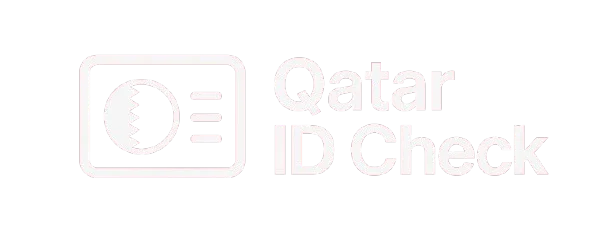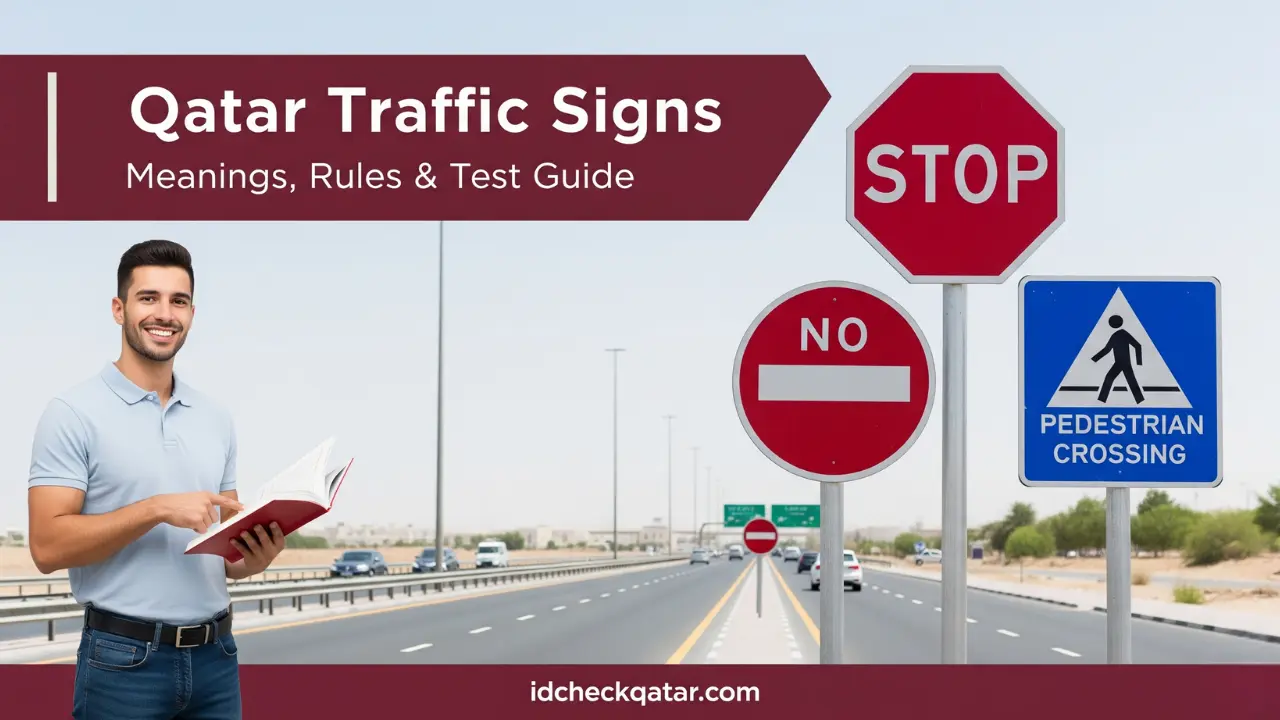Qatar Traffic Signs 2025 – Meanings, Rules & Driving Test Guide
Qatar traffic signs are official road symbols that guide drivers, pedestrians, and cyclists on how to behave on the road. They carry clear meanings, such as when to stop, yield, or follow speed limits, and are essential for road safety and traffic control. Understanding these signs helps drivers avoid violations and penalties under the MOI traffic rules.
Traffic signs in Qatar are not just visual guides; they are part of the broader traffic regulations that keep roads safe and organized. From regulatory signs that mandate actions to warning signs that alert drivers about hazards ahead, each symbol has a clear purpose. For expats and residents, learning these road signs in Qatar is vital for both passing the driving test and driving responsibly in daily life.
The Ministry of Interior (MOI) enforces these rules to ensure smooth traffic flow and reduce accidents. Knowing how these signs connect with Qatar ID services like Qatar ID Check and broader legal frameworks, such as Qatar Traffic Violations gives drivers a full picture of why following signs is mandatory. By respecting traffic regulations in Qatar, drivers not only protect themselves but also contribute to a safer road environment for everyone.
Importance of Qatar Traffic Signs
Traffic signs in Qatar play a crucial role in ensuring road safety, effective traffic control, and effective law enforcement. They are designed to regulate the flow of vehicles, guide drivers, and ensure the protection of pedestrians. Without clear signs, the risk of accidents, confusion, and violations would rise sharply.
Why Qatar Traffic Signs Matter for Drivers
Before diving into categories and meanings, it’s important to understand why these signs are critical.
- Safety: Alert drivers to upcoming hazards such as sharp turns, pedestrian crossings, or construction.
- Traffic Management: Keep cars, buses, and motorcycles moving in an orderly way, even during rush hours.
- Law Enforcement: Disobeying signs is a violation under Qatar Traffic Law and can result in fines or black points.
- Education for Expats: Signs are part of the Qatar driving license test and must be learned by all new drivers.
MOI Enforcement and Legal Backing
The Ministry of Interior (MOI) enforces strict rules connected to traffic signs. According to Article 64 of Qatar’s Traffic Law, damaging, moving, or ignoring a sign can lead to severe penalties, including heavy fines or even imprisonment.
| Aspect | Role of Traffic Signs in Qatar |
|---|---|
| Driver Guidance: | Inform drivers where to stop, turn, or yield. |
| Accident Prevention: | Warn about hazards like uneven roads or school zones. |
| Legal Compliance: | Required by law, violations carry penalties. |
| Public Safety: | Protect pedestrians and ensure smooth mobility for all. |
Categories of Traffic Signs in Qatar
Qatar Traffic Signs are grouped into categories to make them easier to understand and follow. Each category has its own shape, color, and purpose. Drivers must learn these signs not only to pass the Qatar driving license test but also to follow MOI traffic rules on the road.
Regulatory Signs (Mandatory & Prohibition)
Regulatory signs are the most important because they tell drivers what they must or must not do. Disobeying these signs is considered a direct violation of Qatar traffic regulations.
Examples of Regulatory Signs in Qatar:
- Stop Sign – Drivers must come to a complete stop.
- Give Way / Yield Sign – Drivers must let other vehicles pass.
- Speed Limit Signs – Maximum speed allowed on that road.
- No Parking / No Stopping – Prevents congestion and keeps traffic safe.
- No Entry – Restricts vehicles from entering certain roads.
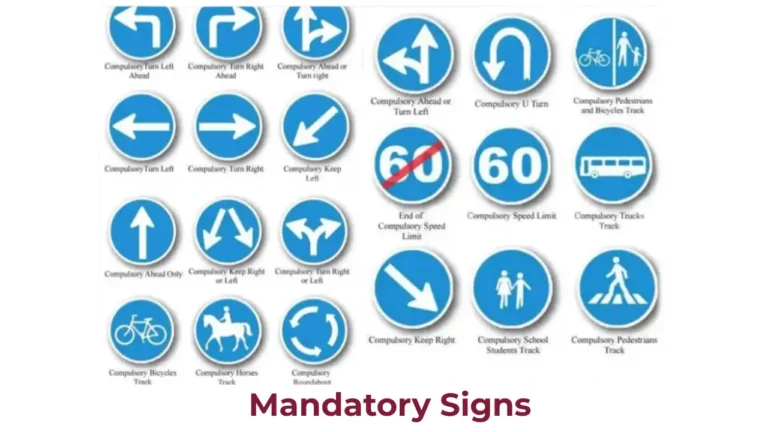
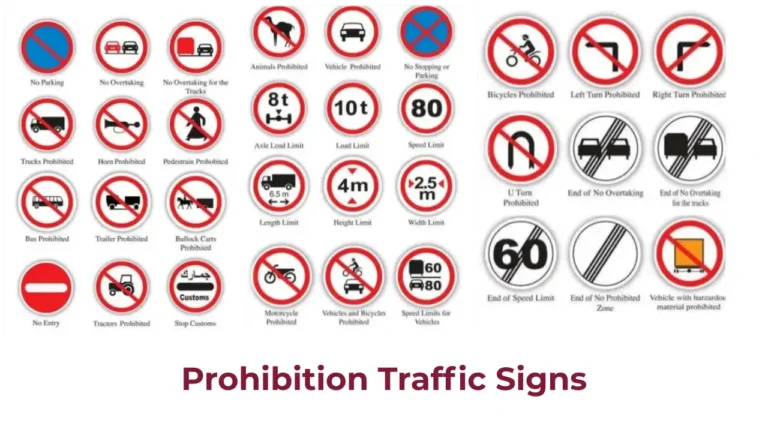
Warning Signs
Warning signs prepare drivers for hazards or changes in the road ahead. They are triangular with a red border and are highly visible to reduce accidents.
Examples of Warning Qatar Traffic Signsr:
- Sharp Turn Ahead – Alerts drivers to reduce speed.
- Pedestrian Crossing – Drivers must slow down and give priority to pedestrians.
- Roadwork Ahead – Indicates construction work on the road.
- Camel Crossing – Found in desert areas, warning of animals.
- Slippery Road – Warns drivers to drive carefully in wet conditions.
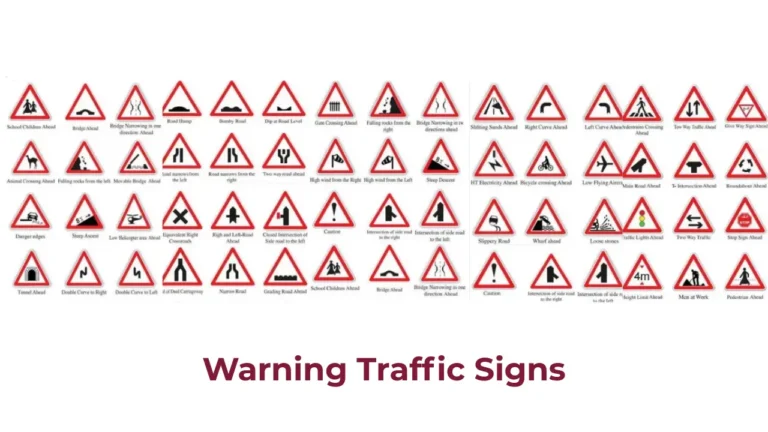
Informational & Directional Signs
These signs give drivers information about destinations, services, and directions. They are rectangular and usually green, blue, or brown in color with Arabic and English text.
Examples of Informational Signs in Qatar:
- Highway Exit Signs – Show upcoming exits on expressways.
- Hospital Signs – Indicate nearby medical services.
- Petrol Station Signs – Help drivers locate fuel services.
- Tourist Destination Signs – Mark historical and cultural places.
- Street Name Signs – Used in cities and neighborhoods.

Temporary / Work Zone Signs
These signs are placed in areas under construction or repair. They are often yellow or orange with black text or symbols. They help drivers navigate safely through temporary changes.
Examples of Temporary Signs in Qatar:
- Detour Sign – Guides traffic to an alternative route.
- Lane Closure – Informs drivers of closed lanes ahead.
- Road Closed – Restricts all access for safety.
- Men at Work – Indicates workers are on the road.
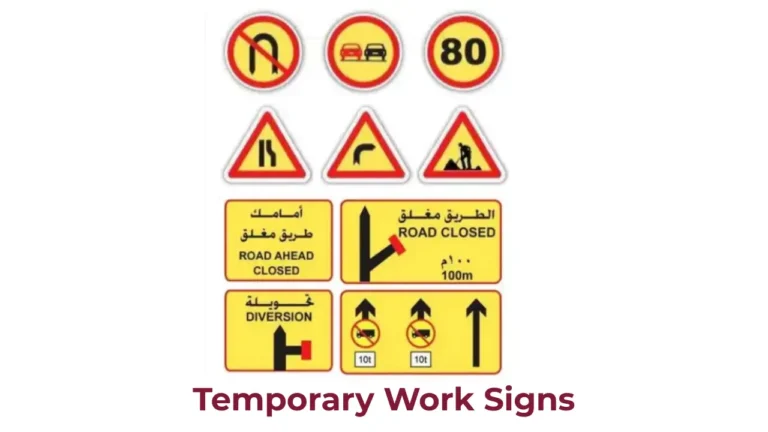
Qatar Traffic Signs and Their Meanings
Qatar Traffic Signs are more than just symbols — they carry legal meanings that every driver must understand. Whether you are preparing for the Qatar driving license test or simply want to avoid traffic violations, knowing the meanings of each sign is essential.
How to Understand Qatar Traffic Signs
Before looking at examples, drivers should know the basic rules that define the meanings of signs:
- Shape: Circles indicate regulations, triangles give warnings, and rectangles provide information.
- Color: Red means prohibition, blue shows mandatory action, yellow/orange signals caution, and green or brown gives directions or destinations.
- Symbols/Text: Bilingual legends (Arabic and English) help both citizens and expats understand.
Common Traffic Signs and Their Meanings
The following table highlights some of the most important Qatar road signs, their meanings, and the penalties for ignoring them.
| Traffic Sign | Meaning | Penalty if Ignored |
|---|---|---|
| Stop Sign | Driver must come to a complete stop before moving forward. | Fine + black points |
| Give Way | Yield to vehicles coming from the main road. | Fine up to QR 500 |
| Speed Limit | Maximum speed permitted on the road. | Speeding fines + black points |
| No Parking | Vehicles cannot park in this area. | Fine + possible vehicle towing |
| Pedestrian Crossing | Drivers must slow down and allow pedestrians to cross safely. | Fine + black points |
| Camel Crossing | Warning of animals crossing in desert/rural areas. | Accident liability + fines |
| Roadwork Ahead | Indicates road construction or maintenance zone. | Ignoring may lead to black points if accidents occur |
| Hospital / Service Sign | Shows the location of essential services like hospitals, fuel, or police. | No penalty — informational only |
| Detour Sign | Temporary alternative route due to road closures. | Ignoring may cause a violation if entering a closed area |
By understanding both the symbols and meanings, drivers stay compliant with MOI traffic rules and ensure safe journeys on Qatar’s roads.
MOI Rules & Penalties for Ignoring Traffic Signs
In Qatar, ignoring traffic signs is not a minor mistake — it is a violation of the Qatar Traffic Law. The Ministry of Interior (MOI) monitors all drivers to make sure road signs are respected. Disobeying a sign may lead to fines, black points, vehicle impoundment, or even imprisonment in serious cases.
Key Legal Backing
- Article 64 of Qatar Traffic Law states that damaging, moving, or changing traffic signs is a serious offense.
- Penalties may include 1–3 years in jail or fines from QR 10,000 to QR 50,000.
- Drivers who ignore road signs such as stop, no entry, or speed limit may receive black points that affect their driving license.
- Repeat violations can double the penalties under MOI rules.
Common Penalties for Ignoring Traffic Signs
| Violation | What It Means | MOI Penalty |
|---|---|---|
| Ignoring a Stop Sign | Driving through without stopping | Fine + 7 black points |
| Entering “No Entry” Road | Driving in a prohibited area | Fine up to QR 500 |
| Exceeding Speed Limit | Ignoring the posted limit sign | Fine (QR 500–QR 10,000) + black points |
| Illegal Parking | Ignoring no-parking signs | Fine + vehicle may be towed |
| Ignoring Pedestrian Crossing | Not yielding to pedestrians | Fine + black points |
| Damaging a Traffic Sign | Destroying, moving, or defacing a sign | QR 10,000–50,000 fine or 1–3 years jail |
If a driver ignores a no-entry sign and enters a one-way street, they risk causing a head-on collision. The fine may look small compared to the damage caused, which is why MOI rules are designed to be preventive and corrective at the same time.
Qatar Traffic Signs for Driving License Test
For anyone applying for a Qatar driving license, knowing the meanings of traffic signs is a must. The test conducted by the Ministry of Interior (MOI) includes both theoretical and practical parts. A large portion of the theory exam focuses on road signs in Qatar.
Why Traffic Signs Are Part of the Test
Traffic signs are included in the exam because they are the foundation of safe driving. The MOI ensures that every new driver understands the signs before being allowed on the road.
- Regulatory signs: Test if drivers can follow rules like stop, yield, and no entry.
- Warning signs: Check if drivers can identify hazards such as pedestrian crossings or sharp bends.
- Informational signs: Measure awareness of navigation and essential services.
- Temporary signs: Ensure drivers know how to act during roadworks or diversions.
Common Signs Asked in the Driving Test
The table below shows some of the signs most frequently included in the Qatar driving license theory test, along with their meanings.
| Sign | Meaning in Test | Why It Matters |
|---|---|---|
| Stop | The driver must fully stop before moving | Tests compliance with basic safety |
| No Entry | Restricted road access | Prevents wrong-way driving |
| Speed Limit | Maximum speed allowed | Reduces accident risk |
| Pedestrian Crossing | Yield to pedestrians | Protects public safety |
| Roadwork Ahead | Indicates construction | Prepares drivers for diversions |
| Roundabout Ahead | Circular junction ahead | Ensures smooth traffic flow |
Tips for Passing the Signs Portion of the Test
- Study the official manual: The MOI provides traffic signs in PDF format for learners.
- Practice visual recognition: Learn to identify signs by shape, color, and symbol.
- Use online quizzes: Driving schools and MOI-approved platforms provide mock tests.
- Focus on unique signs: Such as camel crossings, school zones, and detour signs, which are common in Qatar.
Unique & Special Traffic Signs in Qatar
Not all traffic signs in Qatar are the same as those found in other countries. Some are unique to Qatar’s roads because of its environment, culture, and rapid infrastructure growth. These special signs are important for both locals and expats to understand.
Examples of Unique Traffic Signs in Qatar
These signs appear less often but play an important role in safety and navigation.
- Camel Crossing Signs – Found in desert or rural areas, they warn drivers about animals crossing the road.
- School Zone Signs – Remind drivers to slow down in front of schools during peak hours.
- Smart Digital Signs – Electronic boards that display live traffic updates, diversions, or accident alerts.
- Tourist Destination Signs – Brown-colored boards that guide visitors to cultural or historical sites.
- Bilingual Signs – Most road signs in Qatar include Arabic and English to help expats and visitors.
How to Learn & Remember Traffic Signs in Qatar
Learning Qatar traffic signs is essential for both new drivers and experienced residents. The Ministry of Interior (MOI) and driving schools require all learners to study traffic signs before the driving license test. For expats, this knowledge ensures safe driving and compliance with Qatar traffic regulations.
Best Ways to Learn Traffic Signs in Qatar
Here are effective methods to learn and remember signs quickly:
- Use Official Manuals: The Qatar Traffic Signs PDF and manual are available through driving schools and MOI resources.
- Practice with Driving Schools: Training centers like Doha Driving Academy provide study guides and mock exams.
- Focus on Shapes and Colors: Circles usually mean regulations, triangles mean warnings, and rectangles give information.
- Online Quizzes: Many websites and apps allow learners to test their knowledge with interactive questions.
- Daily Observation: While driving or riding, notice the signs on highways and city streets to reinforce memory.
Helpful Study Resources
| Resource | How It Helps |
|---|---|
| Qatar Traffic Manual (QTM) | Official source with detailed explanations of all traffic signs. |
| Driving School Guides | Provide learner-friendly PDFs with common signs and meanings. |
| MOI Qatar Portal | Shares official traffic law updates and sign interpretations. |
| Mobile Apps & Quizzes | Help practice recognition of road signs through tests. |
| Observation on Roads | Real-world exposure reinforces memory faster than reading alone. |
Memory Tips for Traffic Signs
- Group by Category: Learn signs in sets (regulatory, warning, informational, temporary).
- Use Flashcards: Print signs with meanings on the back for quick practice.
- Associate with Real Situations: Link each sign to an actual driving event, such as slowing down near schools or avoiding no-entry roads.
- Repetition: Review signs daily until they become second nature.
Why This Matters for Drivers
Knowing traffic signs is not only for passing the driving test. It ensures long-term safety, reduces violations, and builds confidence on Qatar’s roads. A driver who recognizes signs instantly can respond faster and avoid dangerous mistakes.
For additional context within your traffic cluster, see related guides such as Traffic Rules in Qatar and practical safety advice like How to Avoid Traffic Violations in Qatar.
FAQs – Qatar Traffic Signs
Conclusion
Traffic signs in Qatar are more than road symbols — they are part of the country’s strict traffic regulations designed to protect lives. Every driver, whether local or expat, must understand and respect them. By doing so, you not only stay compliant with the Ministry of Interior but also contribute to safer, smoother, and more efficient roads for everyone.
